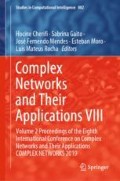Abstract
In this paper, drawing on techniques from patentometrics, network analysis, and probability theory, we model the global system of innovation as a dynamic network. The sphere of technologically relevant knowledge is conceptualized as a reflexive, directed, link- and node-weighted complex network, with distinct spheres of knowledge (or technology domains) representing network nodes and learning (or knowledge flows) across domains acting as inter-nodal links. The empirical knowledge network is constructed from a sweeping patent database, including records from more than 100 patent-granting authorities over the 22-year period spanning 1991–2012. After establishing the structure of the global innovation network, we simulate its dynamics and study its evolution over time. The modelling exercise reveals technological trends and provides a ranking of technologies in terms of their level of technological dynamism.
Access this chapter
Tax calculation will be finalised at checkout
Purchases are for personal use only
Notes
- 1.
- 2.
See [17] for additional discussion of teleportation.
- 3.
This number includes citations to non-patent literature, which are excluded from our analysis.
- 4.
Our database is linked to the January 2006 version of the IPC (also called Version 8), which is divided into 8 sections, 129 classes, 639 subclasses, 7,314 main groups and 61,397 subgroups.
- 5.
- 6.
Because the patent record can contain multiple documents per invention, reflecting different types of legal events, proper handling of the record base is important. Within the same patent office, the multiple events include (but are not limited to) patent application, granting, modification, inclusion of additional claims through a patent of addition, or a divisional patent that splits the claims to an existing invention into separate bundles of rights. Most importantly, there exist applications and grants covering the same invention in multiple jurisdictions. Inclusion of all records in the construction of the knowledge network would lead to distortive duplication. We overcome this potential hazard by extracting the unique invention from the multitude of redundant records.
- 7.
Between 1980 and 1990, data are very sparse, with less than 1000 links annually, so we excluded these years from the analysis.
- 8.
Readers are encouraged to consult the official International Patent Classification system for more detail on the content of patent subclasses.
- 9.
Although the importance of information and telecommunication technology (ICT) is widely recognized, we see from our results that only specific technological domains within the broader ICT constellation of technologies have a key role in the global innovation system.
References
Bohlin, L., Edler, D., Lancichinetti, A., Rosvall, M.: Community detection and visualization of networks with the map equation framework (2014). http://www.mapequation.org/publications.html
Bohlin, L., Viamontes Esquivel, A., Lancichinetti, A., Rosvall, M.: Robustness of journal rankings by network flows with different amounts of memory. J. Assoc. Inf. Sci. Technol. (2015)
Borgatti, S.P.: Centrality and network flow. Soc. Netw. 27(1), 55–71 (2005). http://www.sciencedirect.com/science/article/pii/S0378873304000693
Carnabuci, G., Bruggeman, J.: Knowledge specialization, knowledge brokerage and the uneven growth of technology domains. Soc. Forces 88(2), 607–641 (2009)
Feldman, M.P., Kogler, D.F., Rigby, D.L.: rKnowledge: the spatial diffusion and adoption of rDNA methods. Reg. Stud. 49(5), 798–817 (2015). https://doi.org/10.1080/00343404.2014.980799
Fortunato, S.: Community detection in graphs. Phys. Rep. 486(3–5), 75–174 (2010). https://doi.org/10.1016/j.physrep.2009.11.002
Freeman, L.C., Borgatti, S.P., White, D.R.: Centrality in valued graphs: a measure of betweenness based on network flow. Soc. Netw. 13(2), 141–154 (1991)
Lafond, F.: Knowledge networks. Ph.D. thesis, Maastricht University, December 2015
Lambiotte, R., Rosvall, M.: Ranking and clustering of nodes in networks with smart teleportation. Phys. Rev. E 85(5), 056107 (2012)
Leydesdorff, L.: Patent classifications as indicators of intellectual organization. J. Am. Soc. Inf. Sci. Technol. 59(10), 1582–1597 (2008). https://doi.org/10.1002/asi.20814
Leydesdorff, L., Kushnir, D., Rafols, I.: Interactive overlay maps for US patent (USPTO) data based on international patent classification (IPC). Scientometrics 98(3), 1583–1599 (2014). https://doi.org/10.1007/s11192-012-0923-2
McNerney, J., Fath, B.D., Silverberg, G.: Network structure of inter-industry flows. Phys. Stat. Mech. Appl. 392(24), 6427–6441 (2013). http://www.sciencedirect.com/science/article/pii/S0378437113006948
Newman, M.E.: A measure of betweenness centrality based on random walks. Soc. Netw. 27(1), 39–54 (2005). http://www.sciencedirect.com/science/article/pii/S0378873304000681
Overton, G., Anderson, S.G.: Laser marketplace 2009: photonics enters a period of high anxiety (2009). http://www.laserfocusworld.com/articles/2009/01/laser-marketplace-2009-photonics-enters-a-period-of-high-anxiety.html. Accessed 1 Jan 2009. http://www.laserfocusworld.com/articles/2009/01/laser-marketplace-2009-photonics-enters-a-period-of-high-anxiety.html
Paci, R., Sassu, A., Usai, S.: International patenting and national technological specialization. Technovation 17(1), 25–38 (1997). http://www.sciencedirect.com/science/article/pii/S016649729600065X
Pons, P., Latapy, M.: Computing communities in large networks using random walks. J. Graph Algorithms Appl. 10(2), 191–218 (2006)
Rosvall, M., Bergstrom, C.T.: Maps of random walks on complex networks reveal community structure. Proc. Natl. Acad. Sci. 105(4), 1118–1123 (2008)
Triulzi, G.: Looking for the right path: technology dynamics, inventive strategies and catching-up in the semiconductor industry. Ph.D. thesis, Maastricht University, December 2015
Valverde, S., Solé, R.V., Bedau, M.A., Packard, N.: Topology and evolution of technology innovation networks. Phys. Rev. E 76, 056118 (2007). https://doi.org/10.1103/PhysRevE.76.056118
Acknowledgements
This work was carried out on the Dutch national e-infrastructure with the support of SURF Foundation. The author is thankful to the Netherlands Organisation for Scientific Research (NWO) for its grant program for high-performance computing and to the staff of SURF. Additionally, this study was partially supported by United Nations University—Maastricht Economic and Social Research Institute on Innovation and Technology (UNU-MERIT). The author is particularly grateful to Jojo Jacob and Mathijs Kattenberg for their help and technical advice during the course of this project. All remaining errors are my own.
Author information
Authors and Affiliations
Corresponding author
Editor information
Editors and Affiliations
Rights and permissions
Copyright information
© 2020 Springer Nature Switzerland AG
About this paper
Cite this paper
Verba, M.A. (2020). “Learning Hubs” on the Global Innovation Network. In: Cherifi, H., Gaito, S., Mendes, J., Moro, E., Rocha, L. (eds) Complex Networks and Their Applications VIII. COMPLEX NETWORKS 2019. Studies in Computational Intelligence, vol 882. Springer, Cham. https://doi.org/10.1007/978-3-030-36683-4_50
Download citation
DOI: https://doi.org/10.1007/978-3-030-36683-4_50
Published:
Publisher Name: Springer, Cham
Print ISBN: 978-3-030-36682-7
Online ISBN: 978-3-030-36683-4
eBook Packages: Intelligent Technologies and RoboticsIntelligent Technologies and Robotics (R0)

